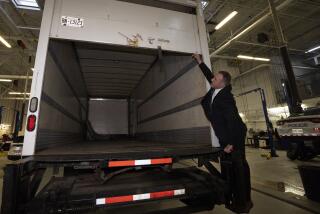Illegal underground hunt takes toll
- Share via
WELKOM, SOUTH AFRICA — Thobela Booi arrived in this mining town with hopes of landing a job that would enable him to support his wife and child. He ended up 5,000 feet underground, killed by the fumes of a raging fire.
Booi, 30, had been one of hundreds of desperate laborers who risk their lives working in the shadows of legal mining operations, sneaking in through abandoned or poorly secured shafts and making their way through a warren of interconnecting tunnels to the ore.
South Africa is the world’s largest producer of gold, and as the bullion price has risen -- and legal mines dig ever deeper to meet the world’s voracious demand -- so have the risks these “gold pirates” are prepared to incur in pursuit of the precious metal.
The gold poaching endangers not only the pirates -- known here as “zama-zamas.” Haphazard digging -- the miners often lack technical skills -- can destabilize shafts, putting thousands of legal miners’ lives at risk.
The pirates can spend weeks, even months underground, with food, drink and even mail ferried to them by runners.
Clandestine mining reportedly produces about $250 million worth of gold a year, but the gold pirates see little of that money. The workers are believed to be recruited by organized crime rackets that ship most of the gold to Switzerland.
The miners, often armed with guns and homemade grenades, have been known to smoke underground and use gas stoves, even in the presence of highly flammable methane gas.
Booi had been missing for six weeks before his body was found. His body was one of 25 brought to the surface at No. 8 Shaft at the St. Helena Gold Mine, outside Welkom, one of the centers of South Africa’s gold mining industry.
The bodies were removed by police from one of the mine’s underground stations in late September. It is believed the miners died from toxic fumes or got caught in a fire that erupted Sept. 18 and blazed for days at an unused section of the mine, five miles from the bodies.
They had been left by their colleagues, who made an anonymous phone call to mine security telling them where to find the bodies. Some had stickers giving their names and hometowns.
Booi didn’t have a sticker. His brother had to identify him among the other bodies.
“I want to know how this happened,” said the brother, Siyabulela Tenge, dazed and angry after seeing Booi’s corpse at the Welkom state mortuary. “How did he go underground?”
Tenge has worked for the Harmony Gold Mining Co., which runs St. Helena. He has been underground and knows the hot and dangerous conditions. He says his brother was ill-prepared for the work: “My brother wasn’t a miner.”
There are several police and mine industry initiatives to tighten security and clamp down on illegal mining. In late September, Welkom police arrested 120 illegal gold miners as they surfaced, probably fleeing the underground fire.
The pirates mine the ore and then extract gold using dangerous mercury, often while still underground or in illegal processing plants.
Although the number of illegal miners underground at any one time is hard to verify, anecdotal accounts put it as high as 1,000.
The municipally owned G Hostel, a wasteland of bungalows and sewage on the outskirts of Welkom, is notorious for being a site from where miners are recruited for illegal operations.
A day after police raided the hostel, reporters were shown the remnants of the crude processes taking place there -- blackened zinc sheets and tin containers in which mercury is burned. Large plastic mining pans stood out amid the filth, some with freshly washed silt coating the bottom -- in them a glitter of gold dust.
One miner, who would not give his name, described the hell at the heart of the gold pit: “Sometimes in the mine it is difficult to identify who is working next to you It’s so dark.”
More to Read
Sign up for Essential California
The most important California stories and recommendations in your inbox every morning.
You may occasionally receive promotional content from the Los Angeles Times.










